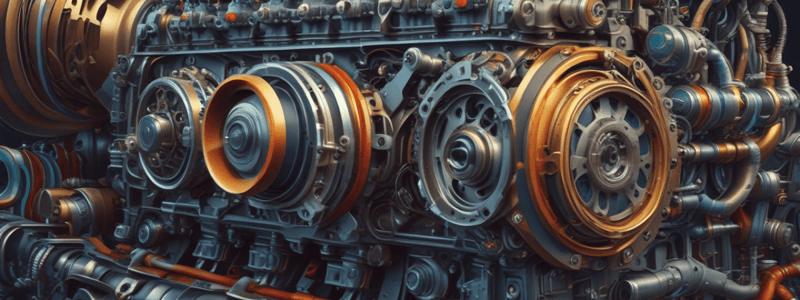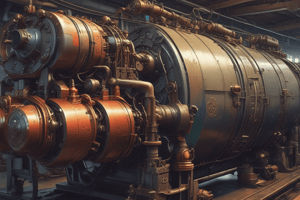Podcast
Questions and Answers
What is camshaft shifting in two-stroke marine engines?
What is camshaft shifting in two-stroke marine engines?
Camshaft shifting refers to the process by which the chain drive for the intake valves changes from one cylinder bank to another when changing direction during operation.
How is camshaft shifting achieved in two-stroke marine engines?
How is camshaft shifting achieved in two-stroke marine engines?
Camshaft shifting is achieved through engagement and disengagement of the chain drives by means of special dog clutches known as camshaft shift dogs.
What is the main reason for implementing camshaft shifting in two-stroke marine engines?
What is the main reason for implementing camshaft shifting in two-stroke marine engines?
The main reason for camshaft shifting is to reduce piston slap caused by uneven combustion pressure between cylinders.
Why is it important to keep the intake and exhaust ports parallel with the gases flowing out of each cylinder in two-stroke marine engines?
Why is it important to keep the intake and exhaust ports parallel with the gases flowing out of each cylinder in two-stroke marine engines?
What are the three common types of camshaft shift mechanisms used in different marine engines?
What are the three common types of camshaft shift mechanisms used in different marine engines?
What role do camshaft shift dogs play in camshaft shifting?
What role do camshaft shift dogs play in camshaft shifting?
How do direct type engines connect the dogs to the intermediate shaft axle?
How do direct type engines connect the dogs to the intermediate shaft axle?
What does the combined rod and direct type engine system use to achieve better efficiency and reliability?
What does the combined rod and direct type engine system use to achieve better efficiency and reliability?
What role does engine rotational direction play in determining the overall performance and durability of a marine engine?
What role does engine rotational direction play in determining the overall performance and durability of a marine engine?
What is the common rotational direction for standard engines in the Northern Hemisphere?
What is the common rotational direction for standard engines in the Northern Hemisphere?
What type of engines typically have a crankpin offset to obtain the desired rotational characteristics?
What type of engines typically have a crankpin offset to obtain the desired rotational characteristics?
What do some manufacturers offer to ensure compatibility with various boat designs and configurations?
What do some manufacturers offer to ensure compatibility with various boat designs and configurations?
Flashcards are hidden until you start studying
Study Notes
Two-Stroke Marine Engines: Understanding Camshift Shifting and Engine Rotational Direction
Two-stroke marine engines have been a popular choice for powering boats due to their simplicity and high performance. However, these engines often come with specific challenges related to camshaft shifting and engine rotational direction. In this article, we will explore these aspects of two-stroke marine engines in detail.
Camshaft Shifting
Camshaft shifting refers to the process by which the chain drive for the intake valves changes from one cylinder bank to another when changing direction during operation. This is done through engagement and disengagement of the chain drives by means of special dog clutches known as camshaft shift dogs. These dogs make contact with each other whenever there is a changeover from one cylinder bank to another.
The main reason for camshaft shifting is to reduce piston slap caused by uneven combustion pressure between cylinders. By shifting the camshafts, the intake and exhaust ports on either side of the crankshaft can be kept parallel with the gases flowing out of each cylinder while being filled by the next set of air/fuel mixture. This ensures efficient combustion and reduces noise levels in the engine.
There are three common types of camshaft shift mechanisms used in different marine engines:
- Push-rod type - In this design, pushrods connect the camshaft shift dogs to the intermediate shaft axle.
- Direct type - Here, the dogs are directly connected to the intermediate shaft axle without any pushrods.
- Combined rod and direct type - This system uses both pushrods and direct connections to achieve better efficiency and reliability.
Each type has its own advantages and disadvantages depending on the specific requirements of the engine application.
Engine Rotational Direction
Engine rotational direction plays a crucial role in determining the overall performance and durability of a marine engine. Most modern marine engines operate using a clockwise rotation for standard engines in the Northern Hemisphere, whereas counterclockwise rotation is common for reverse engines. This difference helps maintain propeller blade angles suitable for thrust generation, which is essential for high-performance maneuvers like turning.
Two-stroke marine engines typically have a crankpin offset to obtain the desired engine rotational characteristics. When mounted on the forward part of the crankcase, the connecting rods cause the crankpins to move horizontally instead of vertically, leading to a more favorable rotational direction. Additionally, some manufacturers offer engines with interchangeable left-hand and right-hand models to ensure compatibility with various boat designs and configurations.
In conclusion, understanding camshaft shifting and engine rotational direction is essential for maintaining optimal performance and longevity of two-stroke marine engines. Proper implementation of these concepts allows boat owners to enjoy a smoother, quieter ride while achieving the necessary maneuverability for safe navigation on the water.
Studying That Suits You
Use AI to generate personalized quizzes and flashcards to suit your learning preferences.




